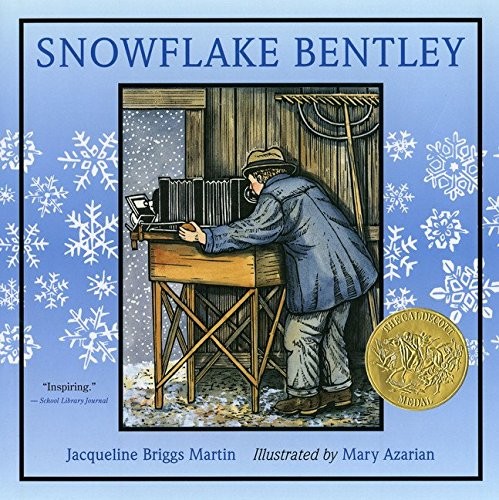January 2017

Snowflake Bentley
by Jacqueline Briggs Martin
"Of all the forms of water the tiny six-pointed crystals of ice called snow are incomparably the most beautiful and varied." — Wilson Bentley (1865–1931)
From the time he was a small boy in Vermont, Wilson Bentley saw snowflakes as small miracles. He determined that one day his camera would capture the wonder of the tiny crystals. Bentley's enthusiasm for photographing snowflakes was often misunderstood in his time, but his patience and determination revealed two important truths: no two snowflakes are alike; and each one is startlingly beautiful. Wilson “Snowflake” Bentley’s story is gracefully told and brought to life in this book, giving children insight into a man who had a scientific vision and a clear passion for the wonders of nature.
A Note from the First Lady:
Dear Read20 Book Club families,
I want to wish you a happy and healthy New Year!
We are excited to launch another year of the Read20 Book Club featuring exciting book selections each month. Remember that just 20 minutes of reading each day can be the best way to learn, increase vocabulary, and improve memory, writing and critical thinking.
This month’s book, Snowflake Bentley, is a biography sharing the true story of Wilson Bentley, a Vermont farm boy who was mesmerized by snowflakes. Once he acquired a microscope with a camera, his childhood preoccupation took on a more scientific leaning, and he went on to publish the first research and photographic images of snowflakes!
Most children are captivated by snow, but how many go on to make it their lifework? I love that Wilson Bentley saw something special and unique in the beauty of snowflakes, and it stirred a deep passion in him. January often brings the chilliest winter weather, and this book is terrific read to explore the beauty of winter. From snowflakes to icicles and snowstorms, I hope this book captures your imagination and curiosity in the natural phenomena that happen around us everyday!
Keep up the great reading,
Crissy Haslam
First Lady of Tennessee
Family Activities
- From the time he was a small boy, Wilson Bentley was fascinated by snowflakes. This was fortunate since he lived in an area of Vermont called the “Snowbelt,” which receives up to 120 inches of snowfall per year! From his work, tell us what was learned about how snowflakes form, why no two snowflakes are alike, and the unique properties of snow. What places on earth get snow and what places do not? What season(s) does snow typically come in? Why?
- Wilson Bentley attracted world attention for his extensive research and scientific investigation of snow crystals (commonly known as snowflakes). Why do you think scientific research is important to understanding the world around us? What careers that involve science and scientific research would you be interested to pursue in the future?
- Discuss geometrical and symmetrical shapes found in nature. Start with a hexagon, the most universal shape of a snowflake. What other things in nature can come in this shape? What other shapes are found in nature? Take a “nature walk” outside around your house, school yard, or in a park or nature preserve. Draw the different shapes that you see on scratch paper or in a journal. Later, discuss what you found and what shapes seem to be most common in nature.
- Make snowflakes by folding and cutting simple white paper. Be sure that each one is different by cutting each paper in random patterns. Hang your snowflakes in a window!
- In addition to the snowflake, describe other natural phenomena that take place where you live or around the world, such as rainbows, thunderstorms, earthquakes, and northern lights. Choose one natural phenomena to research and write about what you learn. Your local library is a great resource for information!